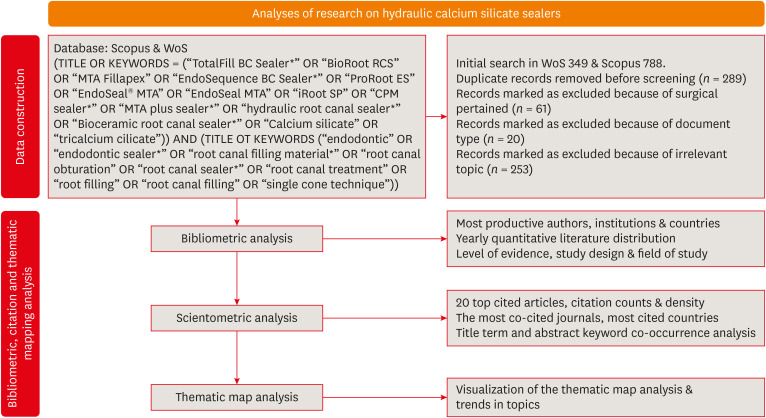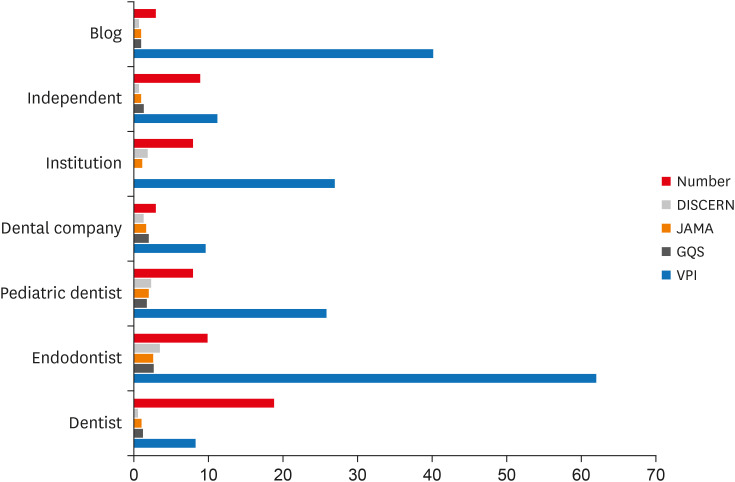-
A scientometric, bibliometric, and thematic map analysis of hydraulic calcium silicate root canal sealers
-
Anastasios Katakidis, Konstantinos Kodonas, Anastasia Fardi, Christos Gogos
-
Restor Dent Endod 2023;48(4):e41. Published online November 13, 2023
-
DOI: https://doi.org/10.5395/rde.2023.48.e41
-
-
 Abstract Abstract
 PDF PDF PubReader PubReader ePub ePub
- Objectives
This scientometric and bibliometric analysis explored scientific publications related to hydraulic calcium silicate-based (HCSB) sealers used in endodontology, aiming to describe basic bibliometric indicators and analyze current research trends. Materials and MethodsA comprehensive search was conducted in Web of Science and Scopus using specific HCSB sealer and general endodontic-related terms. Basic research parameters were collected, including publication year, authorship, countries, institutions, journals, level of evidence, study design and topic of interest, title terms, author keywords, citation counts, and density. ResultsIn total, 498 articles published in 136 journals were retrieved for the period 2008–2023. Brazil was the leading country, and the universities of Bologna in Italy and Sao Paolo in Brazil were represented equally as leading institutions. The most frequently occurring keywords were “calcium silicate,” “root canal sealer MTA-Fillapex,” and “biocompatibility,” while title terms such as “calcium,” “sealers,” “root,” “canal,” “silicate based,” and “endodontic” occurred most often. According to the thematic map analysis, “solubility” appeared as a basic theme of concentrated research interest, and “single-cone technique” was identified as an emerging, inadequately developed theme. The co-occurrence analysis revealed 4 major clusters centered on sealers’ biological and physicochemical properties, obturation techniques, retreatability, and adhesion. ConclusionsThis analysis presents bibliographic features and outlines changing trends in HCSB sealer research. The research output is dominated by basic science articles scrutinizing the biological and specific physicochemical properties of commonly used HCSB sealers. Future research needs to be guided by studies with a high level of evidence that utilize innovative, sophisticated technologies.
-
Citations
Citations to this article as recorded by  - Agri-Food Sector: Contemporary Trends, Possible Gaps, and Prospective Directions
José Roberto Herrera Cantorani, Meire Ramalho de Oliveira, Luiz Alberto Pilatti, Thales Botelho de Sousa
Metrics.2025; 2(1): 3. CrossRef - Scientific mapping of experimental research on solar cookers: Global trends, evolution, and future directions
Flavio Odoi-Yorke, Bismark Baah, Richard Opoku
Solar Energy Advances.2025; 5: 100093. CrossRef - A bibliometric analysis of global research trend and progress on Dy doped materials
Sangeeta Kadyan, Manju Nain, Ashima Makhija, Poonam Punia, Anil Ohlan, Sajjan Dahiya, R. Punia, A.S. Maan
Journal of Alloys and Compounds Communications.2024; 3: 100006. CrossRef - Comparative bioactivity and immunomodulatory potential of the new Bioroot Flow and AH Plus Bioceramic sealer: An in vitro study on hPDLSCs
José Luis Sanz, Sergio López-García, David García-Bernal, Francisco Javier Rodríguez-Lozano, Leopoldo Forner, Adrián Lozano, Laura Murcia
Clinical Oral Investigations.2024;[Epub] CrossRef - Analyzing collaboration and impact: A bibliometric review of four highly published authors’ research profiles on collaborative maps
Willy Chou, Julie Chi Chow
Medicine.2024; 103(28): e38686. CrossRef
-
373
View
-
13
Download
-
2
Web of Science
-
5
Crossref
-
YouTube as a source of information about pulpotomy and pulp capping: a cross sectional reliability analysis
-
Konstantinos Kodonas, Anastasia Fardi
-
Restor Dent Endod 2021;46(3):e40. Published online July 6, 2021
-
DOI: https://doi.org/10.5395/rde.2021.46.e40
-
-
 Abstract Abstract
 PDF PDF PubReader PubReader ePub ePub
- Objectives
The purpose of this study was to critically evaluate the quality, reliability and educational content of the information of vital pulp treatment videos available on YouTube. Materials and MethodsThe keywords “pulpotomy” and “pulp capping” were searched on YouTube on 5th July 2020, until 60 English language videos of each search term with a duration shorter than 15 minutes were acquired. Video characteristics were recorded and Video Power Index (VPI) was calculated. Reliability and educational quality of videos were evaluated using the Modified DISCERN score, the Journal of American Medical Association (JAMA) benchmark criteria and Global Quality Scores (GQS). Videos were categorized by uploading source. ResultsRegarding pulpotomy, 31.7% of the videos were uploaded by specialists and 68.3% were directed by non-specialists. In the case of pulp capping, the corresponding percentages were 45% and 55%, respectively. Videos uploaded by specialists had significantly higher modified DISCERN, JAMA and GQS scores compared to those uploaded by non-specialists. Endodontists tended to have the highest reliability and VPI scores. ConclusionsYouTube videos on vital pulp treatment contain low educational quality or incomplete information. Low popularity of dental pulp capping and pulpotomy videos may be attributed to the specialized nature of these procedures. As YouTube represents an important source for patient information about different health topics, reliable informative videos should be uploaded by specialized dental professionals.
-
Citations
Citations to this article as recorded by  - Quality of Patient-Centered eHealth Information on Erosive Tooth Wear: Systematic Search and Evaluation of Websites and YouTube Videos
Lena Holland, Amelie Friederike Kanzow, Annette Wiegand, Philipp Kanzow
Journal of Medical Internet Research.2024; 26: e49514. CrossRef - Is it safe to learn about vital pulp capping from YouTube™ videos? A content and quality analysis
Celalettin Topbaş, Tuğçe Paksoy, Ayşe Gülnihal İslamoğlu, Kemal Çağlar, Abdurrahman Kerim Kul
International Journal of Medical Informatics.2024; 185: 105409. CrossRef - Assessment of the quality of oral biopsy procedure videos shared on YouTube
A. Díaz‐Rodríguez, J. Limeres‐Posse, R. Albuquerque, V. Brailo, R. Cook, J. C. Fricain, G. Lodi, L. Monteiro, L. Silva, B. Carey, M. Diniz‐Freitas
Oral Diseases.2024; 30(5): 3081. CrossRef - İmplant üstü protezler hakkında bilgi veren internet sitelerinin okunabilirliklerinin değerlendirilmesi
Tugba TEMİZCİ
Selcuk Dental Journal.2023; 10(4): 156. CrossRef - Online Audio-Visual Information on the Treatment of OSA with Mandibular Advancement Devices: Analysis of Quality, Reliability and Contents
Serena Incerti-Parenti, Maria Lavinia Bartolucci, Elena Biondi, Andrea Fiordelli, Corrado Paganelli, Giulio Alessandri-Bonetti
Applied Sciences.2023; 13(9): 5727. CrossRef - Evaluating YouTube as a Patient Information Source for the Risks of Root Canal Treatment
Stewart McLean, Neil Cook, Alexander Rovira-Wilde, Shanon Patel, Shalini Kanagasingam
Journal of Endodontics.2023; 49(2): 155. CrossRef - Assessment of reliability and information quality of YouTube videos about root canal treatment after 2016
Myoung-jun Jung, Min-Seock Seo
BMC Oral Health.2022;[Epub] CrossRef - Is the YouTube™ a useful resource of information about orthognathic surgery?: A cross-sectional study
Seyma Bayazıt, Bilal Ege, Mahmut Koparal
Journal of Stomatology, Oral and Maxillofacial Surgery.2022; 123(6): e981. CrossRef - YoutubeTM Content Analysis as a Means of Information in Oral Medicine: A Systematic Review of the Literature
Antonio Romano, Fausto Fiori, Massimo Petruzzi, Fedora Della Vella, Rosario Serpico
International Journal of Environmental Research and Public Health.2022; 19(9): 5451. CrossRef
-
237
View
-
11
Download
-
11
Web of Science
-
9
Crossref
-
Top 50 cited articles on dental stem cell research
-
Konstantinos Kodonas, Anastasia Fardi, Christos Gogos, Nikolaos Economides
-
Restor Dent Endod 2020;45(2):e17. Published online February 11, 2020
-
DOI: https://doi.org/10.5395/rde.2020.45.e17
-
-
 Abstract Abstract
 PDF PDF PubReader PubReader ePub ePub
- Objectives
Citation analysis provides a unique insight into how scientific interests and research trends have changed over time. The aim of this study was to report on the 50 top-cited papers in dental stem cell research using the Science Citation Index Expanded provided by the Web of Science database to determine the academic importance of each contribution. Materials and MethodsAfter the screening, article title and type, total citations and citations per year, publication journal, publication year, first and senior authors, country of origin, institution, and university of reprint author were documented for the 50 top-cited articles in dental stem cell research. Keyword analysis was performed to determine which keywords were most/least popular. ResultsTop 50-cited articles were cited between 179 to 2,275 times. The majority of papers were published in 2008 and originated from the United States with the highest contribution from the National Institute of Dental & Craniofacial Research. Journal of Dental Research published the highest number of top-cited articles, followed by Stem Cells and Journal of Endodontics. The greatest number of articles was published by two individual authors, Shi and Gronthos. Among 197 unique keywords, dental pulp stem cells and mesenchymal stem cells were the most frequently used. Thirty-eight of the 50 most cited articles were original articles, and 37 of them were in the field of basic science. ConclusionsBasic science studies in dental stem cell research published in high impact factor journals had the highest citation rates.
-
Citations
Citations to this article as recorded by  - Contemporary research trends on nanoparticles in endodontics: a bibliometric and scientometric analysis of the top 100 most-cited articles
Sıla Nur Usta, Zeliha Uğur-Aydın, Kadriye Demirkaya, Cumhur Aydın
Restorative Dentistry & Endodontics.2023;[Epub] CrossRef - The 100 top-cited articles in uveitis from 1950 to 2022
Li Huang, Wei Yang, Tianyu Yao, Zhiru Zhang, Xiaorong Gao, Yujiao Dan, Yue He
International Ophthalmology.2023; 43(12): 4631. CrossRef - The 50 most-cited articles on temporomandibular disorders: A bibliometric analysis
Martina Ferrillo, Vittorio Gallo, Lorenzo Lippi, Alessandro Bruni, Roberta Montrella, Claudio Curci, Dario Calafiore, Marco Invernizzi, Mario Migliario, Alessandro de Sire
Journal of Back and Musculoskeletal Rehabilitation.2023; 36(2): 279. CrossRef - The 50 most-cited articles on clear aligner treatment: A bibliometric and visualized analysis
Alessandro Bruni, Francesca Giulia Serra, Vittorio Gallo, Andrea Deregibus, Tommaso Castroflorio
American Journal of Orthodontics and Dentofacial Orthopedics.2021; 159(4): e343. CrossRef
-
246
View
-
4
Download
-
4
Crossref
|












